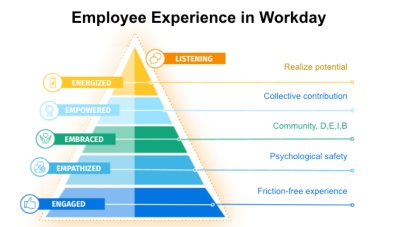How HR Can Deliver Remarkable Employee Experiences
Organizations need greater understanding about their employees’ complete experience—their needs and how they’re feeling—in order to meet them where they are.

Organizations need greater understanding about their employees’ complete experience—their needs and how they’re feeling—in order to meet them where they are.

While it’s not surprising that the pandemic has accelerated digital transformation for many organizations—by months or even years in some cases—it’s also shifted employee priorities. According to research shared by SHRM, organizations can expect a turnover “tsunami,” with a survey showing that 25% of employees plan to quit their jobs once the COVID-19 pandemic subsides and recruiting efforts ramp up. Research from Achievers Workforce Institute also relays sobering data about how workers are feeling:
Organizations need greater understanding about their employees’ complete experience and how they’re feeling in order to meet them where they are. They also need greater virtual support for managers whose employees face more distractions and bigger challenges.
Great employee experiences play a major part in retaining and engaging employees while bolstering their resilience, and they also increase efficiency and productivity of the workforce. While organizations are solving these challenges in the new world of work, they must carefully examine every angle of the employee experience—especially as the complexity and even the definition of that term evolves—and examine the technologies they are implementing for their teams.
Data from Great Place to Work research shows that when companies reduce burnout, employees are 20 times more likely to stay. To build the best possible employee experience, organizations need to keep an open ear to ever-shifting employee needs, act on that feedback, and continuously measure the impact in order to pivot and focus on specific areas that need support. The ones that don’t will be left behind.
To help everyone achieve their maximum potential, organizations should strive to deliver a holistic employee experience that accounts for the entire hierarchy of employee needs:
The way to deliver for employees is to act on employee feedback using innovative technology that can be tailored to individual needs and preferences.
The way to deliver for employees is to act on employee feedback using innovative technology that can be tailored to individual needs and preferences. This helps turn each of the five employee needs areas into meaningful moments that matter.
At Workday, we lean into the rich context and insights we have about our people to help us curate personalized and relevant courses of action to guide them through their experiences. We use tailored processes that weave together content, actions, and approvals across multiple platforms to deliver remarkable employee experiences.
For example, we can identify when an employee is not feeling a sense of belonging, or their overall well-being is low, and we can use this information to create relevant Workday Journeys.
Here are a few examples of how Workday Journeys can support your employees’ needs:

So how do we know what Journeys our Workmates need, and what information we should include?
We survey our employees every week in our Best Workday Survey, and this data provides us with tremendously valuable insights. And now with Peakon as part of Workday, we can listen closer and surface employee sentiment, providing us with an even deeper understanding of our employee needs.
Here’s an example: Perhaps we discover that a certain percentage of our employees don’t want to return to an office. We still need more information about what is making them uncomfortable. Is it the work/life balance they need with new caregiving responsibilities? Do they have concerns about overall sanitation in a building we share with numerous other tenants? With Peakon, we can identify the “why” behind these concerns in real time and develop Workday Journeys based on those details.
In addition to getting snapshots of collected feedback over a given time period, we now have the ability to use intelligent listening to harness the real-time voice of the employee, giving us an accurate pulse on how employees are feeling and doing. Then we can take action, and course correct based on the ability to measure our progress.
Innovations have made it possible for us to amplify employee experiences and meet people where they are, to better engage and empower them in an increasingly complex world.
More Reading

Talent management synchronizes planning, recruitment, development, and evaluation to keep teams agile and engaged. Learn the key roles, frameworks, and metrics that power a robust talent lifecycle.

Five generations. One workplace. In today’s evolving workforce, engaging employees across age groups isn’t just possible—it’s essential for lasting performance and culture.

Hiring is more competitive, more complex, and more consequential in 2025. HR leaders need a clear, flexible, strategic hiring plan to recruit smarter and build a workforce that can stay adaptable.